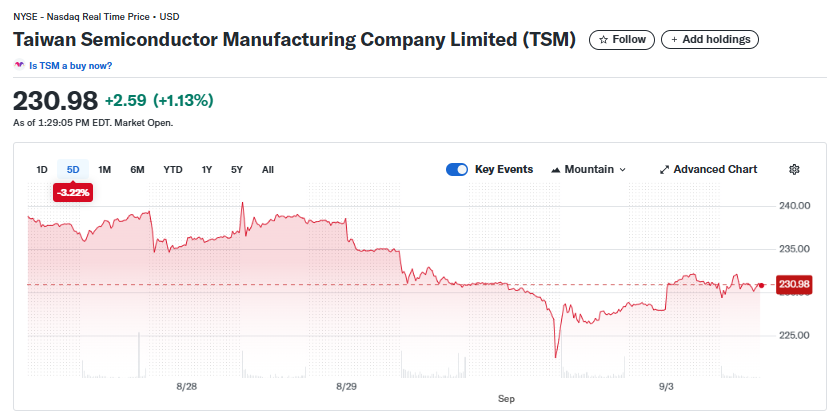TLDRs;
- TSMC stock rose 1.13% to $230.98 on Wednesday despite U.S. moves to end its China export waiver.
- The waiver’s expiration in 2025 means TSMC must seek licenses for restricted equipment shipped to its Nanjing plant.
- Analysts warn of administrative friction, longer lead times, and higher compliance costs for semiconductor firms in China.
- Despite headwinds, TSMC stock stability shows investor confidence in its dominance in global advanced chip manufacturing.
Taiwan Semiconductor Manufacturing Company (TSM) stock showed resilience on Wednesday, closing up just over 1% despite the latest move from Washington to end its export waiver for China.
The stock climbed to $230.98, gaining 1.13% on Wednesday, and held relatively stable through the trading session even as concerns lingered about the long-term implications of U.S. export policy.
The U.S. Commerce Department announced that TSMC’s validated end user (VEU) waiver, which allowed the company to ship certain restricted semiconductor equipment to its Nanjing, China plant, will expire on December 31, 2025. After this date, the chip giant will need individual licenses for exports, a significant shift from blanket permissions that previously simplified operations.
This policy mirrors actions already taken against Samsung Electronics and SK Hynix, signaling that Washington intends to close what officials describe as “export control loopholes” in advanced technology trade.

TSMC’s Stock Performance Shows Stability
Despite geopolitical tensions, TSMC’s share performance highlights investor confidence in its market position. Over the past five trading days, the stock experienced some volatility, dipping late August before rebounding in early September. The 1% surge on Wednesday suggests that investors view the company’s long-term fundamentals as intact.
Market watchers believe the limited impact stems from the relatively small share of revenue tied to its Nanjing facility, which accounts for just a fraction of TSMC’s global output.
Still, the changes could introduce administrative and operational friction, including potentially longer lead times and compliance costs that may affect competitiveness in China.
Export Rules as a Strategic Weapon
Analysts note that the shift from blanket waivers to case-by-case licensing illustrates how bureaucratic processes can serve as policy tools in the U.S.-China tech rivalry. Instead of outright bans, Washington is relying on regulatory hurdles to restrict sensitive technology transfers.
Taiwanese chip giant TSMC won't be able to ship key equipment to its main facility in China easily. The United States has revoked the company's fast-track China export status. pic.twitter.com/NkZvhjl68M
— NTD (@NTD_Live) September 2, 2025
According to estimates, the new system could generate over 1,000 additional license applications annually, creating paperwork burdens for TSMC and its suppliers. While most licenses may still be approved, the uncertainty over timing could disrupt supply chain planning and add hidden costs to doing business in China.
This approach allows the U.S. to maintain leverage without escalating into more aggressive measures that could trigger diplomatic fallout. The strategy reflects Washington’s broader push to control critical supply chains where U.S.-made equipment and components give it global influence.
Broader Geopolitical Context
The export control development follows other headlines surrounding TSMC. Just last month, company CEO C.C. Wei reassured investors that the U.S. government will not seek an equity stake in the firm, despite earlier media speculation tied to CHIPS Act subsidies. That reassurance helped stabilize investor sentiment after shares had briefly fallen in Taipei on related rumors.
Together, these events underline the delicate balance TSMC faces. On one hand, it is expanding globally with new fabs in the U.S. and Japan, strengthening its role in securing advanced chip supply chains. On the other, it must navigate geopolitical headwinds in China, where even small operational exposures can become points of vulnerability.





